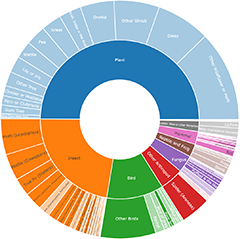Moths (Lepidoptera)
Useful references:
- CSIRO's Australian National Insect Collection (ANIC) - Australian Moths Online
- Don Herbison-Evans web pages:
In the notes provided about individual species, semi-technical terms are sometimes used. They are briely explained below.
Labial palpi. These are paired appendages extending from the lower part of the head, on either side of the proboscis. They provide important information about the family of the moth.
Parts of a moth’s wing:
Costa: The leading edge of the wing
Inner margin: The trailing edge of the wing
Termen: The outer margin of the wing, connecting the costa to the inner margin
Apex: The leading tip of the wing, where the costa and termen meet
Tornus: The trailing corner of the wing, where the termen and inner margin meet
Cilia. Long hairy scales along an edge of the wing
Announcements
Hello NatureMaprsAs we move into the cooler months and sighting counts begin to wind down our team has been working tirelessly to ensure our platform’s usability and performance. All merch has been po...
Continue reading
Improvements to data import tool (coming soon)
NatureMapr welcomes Edgar McNamara
Platform wide attribute changes
New Feature: Moderator Quick Responses!
Discussion
Stictochila (genus)
but I'm not sure I could call 4668791 P. agnesella though,
Philobota agnesella
Philobota group
Eulechria atmospila
Top contributors
- kasiaaus 5.8K
- jb2602 3K
- PJH123 2.2K
- WendyEM 1.9K
- AlisonMilton 1.7K
- ConBoekel 1.6K
- Hejor1 1.3K
- Bron 1.2K
- SteveBorkowskis 1.1K
- GlennCocking 1K
Top moderators
- donhe 17K
- ibaird 14.8K
- GlennCocking 3.4K
- DianneClarke 1.7K
- WendyEM 815
- MichaelMulvaney 626
- JulieMorgan 173
- MichaelBedingfield 172
- kasiaaus 130
- KimPullen 97



